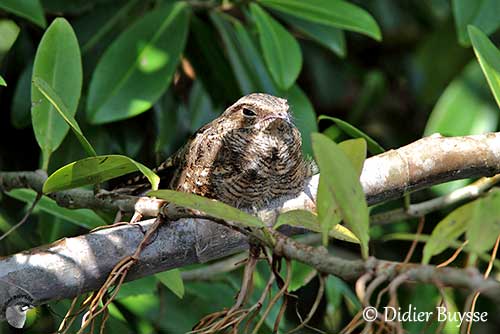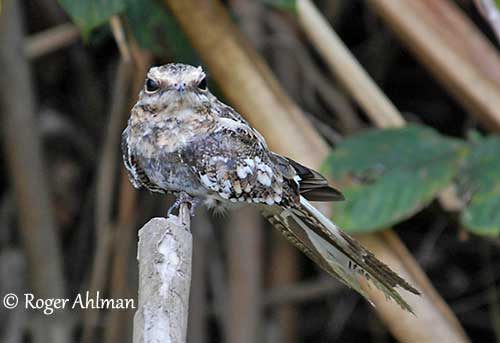
Fr: Engoulevent trifide
Ang: Ladder-tailed Nightjar
All: Staffelschwanz-Nachtschwalbe
Esp: Chotacabras de Escalera
Ita: Succiacapre scalare
Nd: Trapstaartnachtzwaluw
Sd: gaffelstjärtsnattskärra
Photographers:
Roger Ahlman
Pbase Galleries Peru and Ecuador
Didier Buysse
Vision d’Oiseaux
Texte de Nicole Bouglouan
Sources:
HANDBOOK OF THE BIRDS OF THE WORLD Vol 5 by Josep del Hoyo-Andrew Elliott-Jordi Sargatal - Lynx Edicions - ISBN: 8487334253
NIGHTJARS - A Guide to Nightjars and Related Nightbirds – Nigel Cleere and Dave Nurney - Yale University Press - First Edition (August 11, 1998) - ISBN 10: 0300074573 / ISBN 13: 9780300074574
A GUIDE TO THE BIRDS OF COLOMBIA by Steven L. Hilty and William L. Brown - Princeton University Press – ISBN 069108372X
BIRDS OF PERU by Thomas S. Schulenberg, Douglas F. Stotz, Daniel F. Lane, John P. O’Neill, Theodore A. Parker III–Princeton University Press 2007–ISBN: 978-0-691-13023-1
Notes on the breeding biology of Ladder-tailed Nightjar Hydropsalis climacocerca in Bolivia By Aidan Maccormick and Ross MacLeod
Arthur Grosset's Birds (Arthur Grosset)
Fatbirder - Caprimulgidae – Nightjars & Nighthawks
Wikipedia, the free encyclopaedia
Ladder-tailed Nightjar
Hydropsalis climacocerca
Caprimulgiformes Order – Caprimulgidae Family
INTRODUCTION:
The Ladder-tailed Nightjar is a South American species found in the Amazon Basin. The genus Hydropsalis includes two species, and the second is the Scissor-tailed Nightjar. Both species have a ‘trident-shaped” tail, especially evident in males.
The Ladder-tailed Nightjar frequents subtropical and tropical moist shrubland, but it is often seen close to rivers where it perches on sandbars, stones and rocks.
It feeds on insects caught in the air by hawking along water edges. Like other nightjars, the eggs are laid directly on the ground because it does not build a nest.
The Ladder-tailed Nightjar is described as “fairly common” throughout the wide range, and the species is not globally threatened.

DESCRIPTION OF THE BIRD:
Biometrics:
Length: 24-26 cm
Weight: M: 42-46 g – F: 45-52 g
The Ladder-tailed Nightjar has grey-brown plumage overall.
The male has brownish upperparts with blackish vermiculations and fine streaking. The nuchal collar is buffish.
The scapulars are blackish-brown with broad buff edges on outer webs. The wing-coverts are brown to greyish-brown with buffish spots. The blackish primaries are crossed by a broad, white band, well visible in flight.
The male has W-shaped tail formed by long, mostly white, forked outer rectrices, and equally long central pair of grey feathers. Other rectrices are shorter.
The underparts are greyish-brown or brown, with buff bars and spots. Belly and flanks are buff and barred brown. The throat patch is white.
On the head, we can see a white submoustachial stripe.
The bill is blackish. The eyes are dark brown. Legs and feet are brownish.
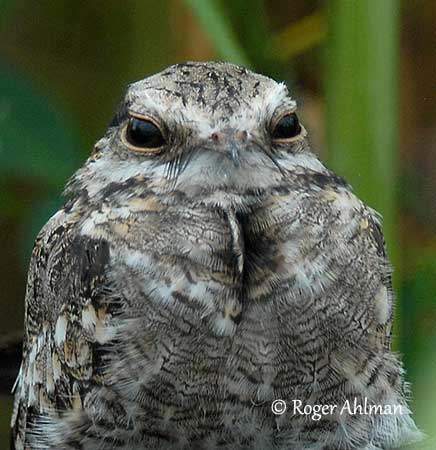
The female resembles male but the throat patch is buffish. The white wing bands are narrower and edged or washed buffish across the four outer primaries. The tail is less strongly shaped and the white markings are often absent.
Immature and juvenile resemble adult female, but the wing bands are buffish and the belly is less barred.
SUBSPECIES AND RANGE:
The Ladder-tailed Nightjar has five subspecies which differ in size and coloration. All races are presumably sedentary.
H.c. climacocerca (described above) is found in SE and E Colombia, E to S Venezuela and N Brazil, S to E Ecuador, E Peru and N and E Bolivia.
H.c. schomburgki occurs in E Venezuela and the Guianas.
H.c. pallidior is found in NC Brazil, but it is only known from Santarém in W Pará.
H.c. intercedens occurs in NC Brazil, only from Obidos in W Pará.
H.c. canescens is also found in NC Brazil, only from R Tapajós in W Pará.
The races “pallidior”, “intercedens” and “canescens” occur along a 120 km stretch of the lower Amazon, between Obidos and Santarém. The race “intercedens” is sometimes lumped within “pallidior”.
The validity of all tree subspecies is questionable.
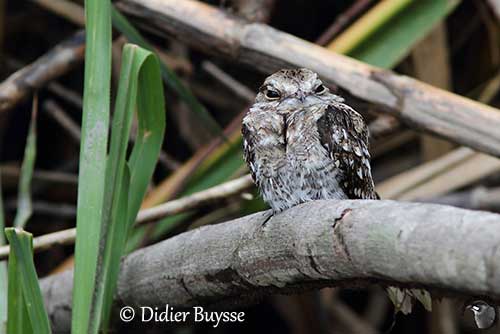
HABITAT:
The Ladder-tailed Nightjar frequents rainforest, open woodland and secondary growths, but it is often observed on river banks, sandbars, stones and rocks in the middle of the water.
It is primary seen from sea-level to 600 metres, but locally up to 1,000 metres of elevation in E Ecuador, and it may more occasionally enter intermontane valleys of E Peru, up to 2,600 metres of elevation.
CALLS AND SONGS: SOUNDS BY XENO-CANTO
The Ladder-tailed Nightjar gives a distinctive sucking “sip” call when perched, and we can also hear a chirping “chip” monotonously repeated every 1-2 seconds. When flushed, it gives a soft “chewit” or “cheeit”.
The song in flight is a rasping “kweek” note interspersed with a ringing whistled rattle.
During the displays, the wings produce a whistling/humming noise.
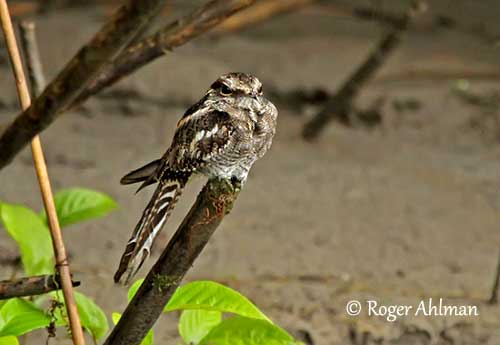
BEHAVIOUR IN THE WILD:
The Ladder-tailed Nightjar probably feeds on insects. The nightjars usually hunt by sallies from perches or from the ground, but they also hawk flying prey on riverbanks.
It roosts on the ground, sometimes in thickets or on sandbars on riverbanks. They may roost in small groups of 3-4 individuals, probably family groups, but more often in pairs.
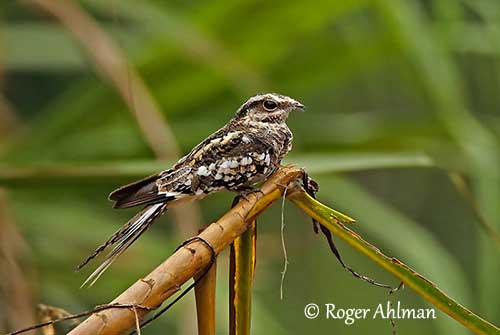
The Ladder-tailed Nightjar performs aerial displays to attract a female, making usually low flights over the water. The display starts with one or two males pursuing a female in flight. The male has erratic flight above and behind the female, at about 1 metre from her, while giving an excited “skeet”.
Another display involves lowering and fanning of the male’s tail while flapping the raised wings. The latter movement produces a whistling/humming noise and the male hovers briefly. These displays are repeated close to the female.
This behaviour was observed in strong moonlight.
The Ladder-tailed Nightjar is sedentary.
It performs shot flights if flushed, and re-alights very quickly.
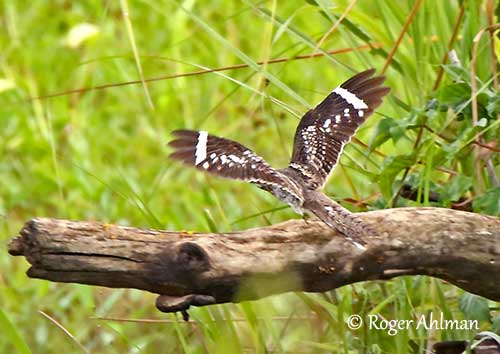
REPRODUCTION OF THIS SPECIES:
The breeding season varies depending on the range. It occurs in July/August in Colombia, in June/September and December/February in Brazil. Information is lacking for other parts of the range.
The Ladder-tailed Nightjar does not build a nest. The eggs are laid directly on sandy soil or bare ground. The nest-site is often situated on exposed rocky riverbanks or in shady place under or close to vegetation.
It is usually a shallow depression or a scrape in the ground, in sand or fine gravel, usually very close to a small plant.
The female lays 2 pale olive eggs with grey and brown markings. Incubation and fledging period are not known.
At hatching, the chicks are covered in pale grey down with grey and brown speckles. No more information.
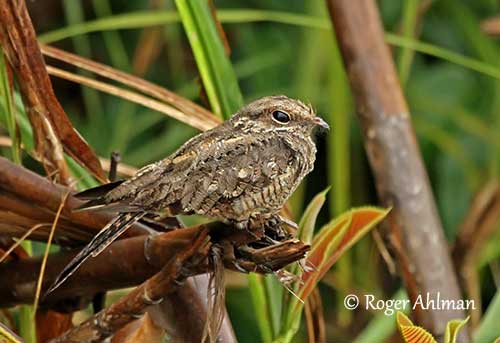
PROTECTION / THREATS / STATUS:
The Ladder-tailed Nightjar is common to fairly common throughout the wide range.
The species occurs in some protected areas such as reserves and national parks.
The size of the population is unknown, but it is suspected to be stable.
The Ladder-tailed Nightjar is not globally threatened, and currently evaluated as Least Concern.
